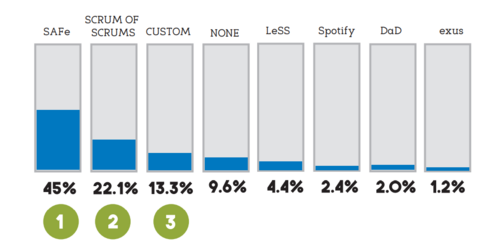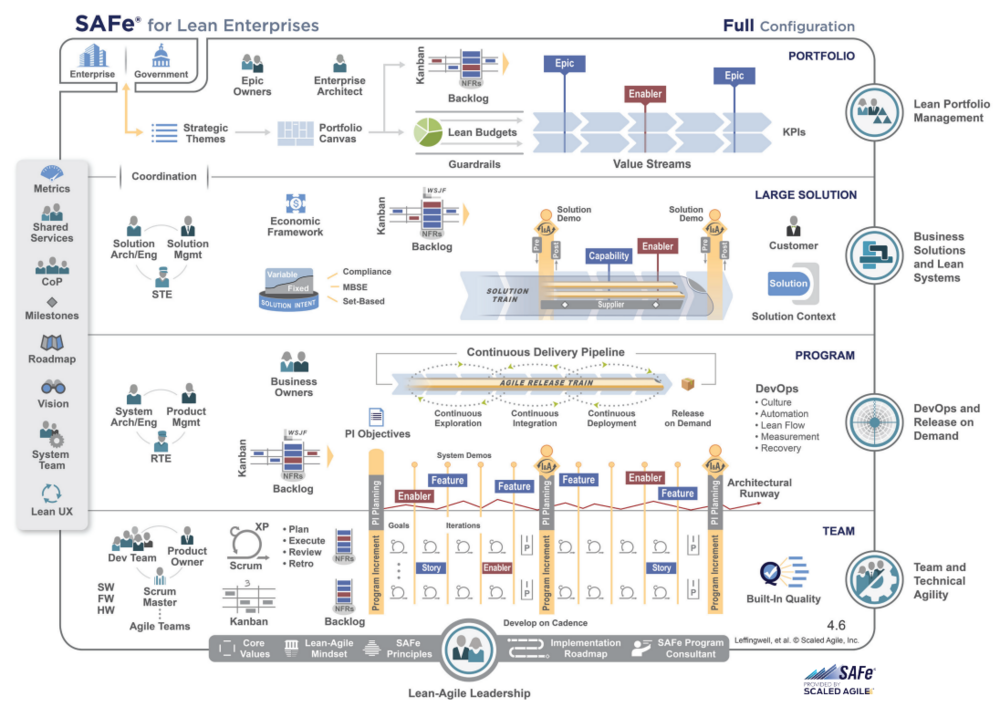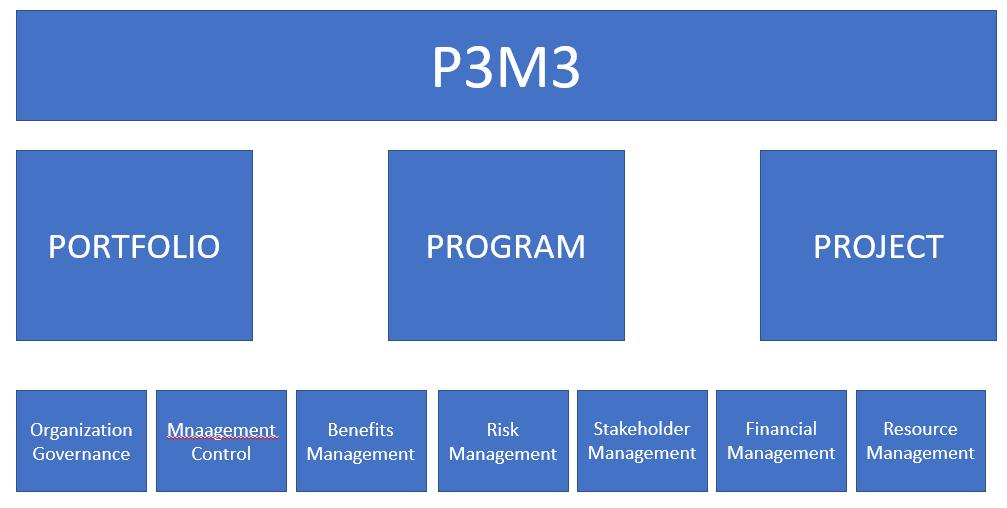(Re)Introducing Project Management in a SAFe world
Prior to 2017 Scaled Agile Framework (SAFe) had no concept of a PMO. With SAFe versions 4,5 the model begins to re-introduce the functions of a PMO. Companies that implemented the earlier versions of SAFe could benefit from (re)introducing a PMO. This article addresses issues with not having a PMO and best practice for (Re)introducing a PMO. It is intended for SAFe practitioners, Project, Program and Portfolio Managers and Executives that lead Agile organizations.
By Ben Blackburn
Contents |
Background
Traditionally Software development has utilized Project, Program and Portfolio Management to support waterfall delivery. In response to long times to market and inefficient bureaucratic practices, new 'Agile' approaches to software development emerged:
1986 Scrum (1986 Hirotaka Takeuchi and Ikujiro Nonaka / 1990's Jeff Sutherland, Ken Scwaber, John Scumniotales and Jeff McKenn),
1990's Design Thinking (but originally created in the 1960's for product management)
1996 Extreme programming (Kent Beck),
1996 Lean (Womacjk & Jones)
2001 The Agile manifesto
2008 DevOps (late 1990's crystalizing in Pätrick Debois 2008/9) & LAterly DevSecOps
The Agile practices gave significant advantage to the companies utilizing them and grew rapidly in popularity and adoption. As large enterprises discovered the value of the Agile practices, demand for deploying these approaches at scale grew. In response new Agile methods at scale emerged such as:
2005 Large Scale Scum (LeSS)
2011 Scaled Agile Framework (SAFe)
2015 Disciplined Agile Delivery (DAD)
From the mid 2010's Agile practices grew in recognition and were regularly featured in popular business literature such as Forbes and Harvard Business Review.[1] [2]. Those companies that adopted these practices gained significant success with results such as "98% experiencing success with Agile practices" and "75% saying that more than half of their Agile projects were successful" [1] Competition created an imperative for most software organizations to change and adopt these practices.
During the period 2011-2017 Early versions of SAFe took many traditional Project, Program & Portfolio Management (PPPM) responsibilities and moved them into the new SAFe's roles such as Product Owners, Scrum Masters, RTE, Epic and Business Owners. With the most popular Enterprise scale Agile model in the world [3] Scaled Agile Framework (SAFe), effectively advocating removing Project Management from development organizations PPPM within many software development Organizations literally had no place. This is important because as of 2017 the SAFe methodology was used by 45% [3] of those firms using an Agile methodology at scale. [3]

As a consequence many companies have had to contend with a variety of issues caused by the removal of PPPM practices and would benefit from (Re)-introducing them. Issues:
- During Implementation - General issues with Scaled Agile Frameworks
Note: Due to the relatively new and evolving nature of SAFe there is limited empirical data around specific “Implementation issues in Large Scale Agile transformations” [4]. As a consequence this article is more reliant more on Anecdotes, Personal Experience and other literature in this space.
Scaled Agile Framework (SAFe)
What is SAFe?
According to ScaledAgileFramework.com[5]:
“SAFe® for Lean Enterprises is a knowledge base of proven, integrated principles, practices, and competencies for achieving business agility using Lean, Agile, and DevOps.” “It “…is built around the Seven Core Competencies of the Lean Enterprise that are critical to achieving and sustaining a competitive advantage in an increasingly digital age” Dean Leffingwell (the creator and chief methodologist of SAFe) [5]
ScaledAgileFramework.com makes this framework and support material available to all along with an extensive library of resources that can be used for free to support implementing and running SAFe in practice
The seven core competencies:
SAFe is based on these 7 Competencies: [5]
- Lean-Agile Leadership – Advancing and applying Lean-Agile leadership skills that drive and sustain organizational change by empowering individuals and teams to reach their highest potential
- Team and Technical Agility – Driving team Agile behaviors as well as sound technical practices including Built-in Quality, Behavior-Driven Development (BDD), Agile testing, Test-Driven Development (TDD), and more
- Agile Product Delivery – Building high-performing teams-of-teams that use design thinking and customer-centricity to provide a continuous flow of valuable products using DevOps, the
- Continuous Delivery Pipeline, and Release on Demand Enterprise Solution Delivery – Building and sustaining the world’s largest software applications, networks, and cyber-physical solutions
- Lean Portfolio Management – Executing portfolio vision and strategy formulation, chartering portfolios, creating the Vision, Lean budgets and Guardrails, as well as portfolio prioritization, and road mapping
- Organizational Agility – Aligning strategy and execution by applying Lean and systems thinking approaches to strategy and investment funding, Agile portfolio operations, and governance
- Continuous Learning Culture – Continually increasing knowledge, competence, and performance by becoming a learning organization committed to relentless improvement and innovation"
Levels & Objectives
SAFe's model aims to create an optimized "continuous delivery pipeline" via one or many Agile Release Trains (ARTs). There are 4 levels of SAFe suggested - "Essential", "Large Solution", "Portfolio" and a "Full" SAFe. All of ARTs should deliver improvements in delivery efficiency but at the Portfolio and Full levels the suggested organization changes to focus organization around the delivery of value with a more strategic portfolio emphasis relevant to larger companies that may have significant numbers of people working in a wide range of different business areas or providing a wide range of services
Introduction of Project, Program and Portfolio management into SAFe
From SAFe 4,5 onwards we start to see the introduction of formal portfolio management processes as historically defined. First with Lean Budgets in V4,5 and then more features in each version until SAFe V5.0 which effectively introduces full portfolio management and portfolio optimization capabilities in the traditional PPPM sense.
In particular the APMO's roles facilitating 1) generation and changes to the Portfolio level Kanbans & Backlogs, 2) supporting Lean Budgets as well as 3) monitoring Portfolio Value, 4) project and program budget "Guardrails", combined with 5) aligning with the Lean Center of Excellence all seem very well aligned with a P3O descriptions of the roles of a traditional program or portfolio office.
What are the benefits of SAFE?
As advertised on ScaleAgileFramework.com:
20 – 50% increase in productivity
25 – 75% improvements in quality
30 – 75% faster time-to-market
10 – 50% increase in employee engagement and job satisfaction
While Quality improvements and Employee engagement and satisfaction can be pretty straightforward to report and compare, productivity and time to market are much harder to compare directly before and after an agile transformation. Increases in productivity are often very difficult to quantify when the basis changes (I.e from hours to stories) how do you compare these apples and oranges? Likewise with Time to market - if estimation comparisons are flawed so is time to market.
That said - and working back from quality metrics with some basic assumption (like the bugs that didn't need fixing after release are now available for new development) INSERT IBM COST OF BUGS TO FIX it seems logical that organizations gain significant efficiency improvements through SAFe
My personal experience at a Mid Sized software firm was introducing basic Agile practices such as cross functional team Scrum to a traditionally Waterfall organization raised productivity from 70-80% of estimated scope per to circa 104% within 12 months. In the case I mention we had the rare situation of 3 Agile teams having the old waterfall estimation process running throughout the period as the main development organizations processes still required the provision of hourly estimates. Therefore the figures are not subject to comparison errors as is usual during an agile transformation. This experience would seem to support the kind of figures SAFe advertise.
General issues raised with SAFe
The below lists are compiled from Research on these topics supplemented by examples from my experience
During Implementation
General issues with SAFe
Conboy and Carroll in their 2019 study : "Implementing Large-Scale Agile Frameworks: Challenges and Recommendations[6]
Report issues across implementations of different scaled frameworks but the themes contain challenges that those thathave implemetend SAFe will recognize.
Issues 1,2,3,4 & 7 in the report are generally related to the implementation but 5.6.8 & 9 can be seen after implementation.
5.Top-down versus Bottom-up Implementation of Large-Scale Agile Frameworks For example: Bottom up models tend to create large numbers of teams that have fragmented working practices, Tooling, Methods of communicating, Definitions of done etc. This can create additional complexity coordinating amongst teams and getting a clear picture of the organization from the top. Whereas Top down models tend to take the enthusiasm out of the Agile transformation by being seen a prescriptive and unresponsive to the needs to the teams PMO's can support the bottom autonomy while helping deploy best practice and standards that may be needed across ART's and Value Trains to support consolidated business level planning for the top
6.Over-emphasis on 100% Framework Adherence over Value For example: Maintenance teams that rely on kanban for their workload management being called into PI planning events and 2 weekly sprint cycles despite the practice being wasteful and unneccessary for the team.
8.Maintaining Developer Autonomy in Large-Scale Agile Frameworks For example: Autonomy and flexibility in choice of tooling is difficult to scale as corporate IT systems and policies are not designed to support unlimited variety in tooling. Tooling often also represents the working behaviors, practices and limits of teams activities and the variety of working practices works against the principles of flexibility of the teams across the whole organization to work together on new challenges. Dependency Management can also be problematic when there are a wide variety of practices
9.Misalignment between Customer Processes and Large-Scale Agile Frameworks Manifests in 2 forms. Customer engagement especially on larger Epics is not well accounted for. Agile suggests customer engagement but SAFe stops at the Epic Owner assuming the are always aligned with the customer. But there is also a wider point that SAFe does not have specific customer engagement roles which may be required to manage for example: large Client contract relationships. It is also does not account well for management of third parties and interfaces with the wider enterprise it operates in.
- PMO's can provide flexible resources to help deal with things like supporting the development organization deal with external stakeholders
(Re) Introducing a SAFe APMO
Motivation for (Re)Introducing an (A)PMO
Formal Portfolio Management is a best practice in successful Agile companies
Market Research from CA Technologies suggests that "Agility Masters" (defined as the top 18% of respondents in terms of maturity of Agile and DevOps practices) are:
1) 3,2 times more likely to strongly agree that portfolio management has a key role to play in organizations
2) 4.1 times more likely to agree the company has the right Vision and strategy [7].
This leads to the conclusion that larger companies benefit the most from Implementing SAFe with a strong PMO supporting strategy formation and execution regardless of any specific direction or lack of direction about this from SAFe.
PMO's address many of the problems raised with early versions of SAFe
The study "Recurring Concerns and Best Practices of Agile Coaches and Scrum Masters" [8] Analyzes the issues raised by Scrum Masters and Agile coaches. The issues are analyzed and specific best practices within Agile suggested to resolve them. The conclusion of the study is that the majority of issues in SAFe implementations can be addressed with the mediating actions below. (1) PUBLISH GOOD PRACTICES (2) SUPERVISION (3) GLOBAL IMPEDIMENT PROCESS (4) GLOBAL IMPEDIMENT BOARD (5) DON’T USE SCALING AGILE FRAMEWORKS AS A RECIPE
When modified to apply to fits very well with many activities performed by a formal PMO along the lines of the those recommended by Axelos or the PMI. Points 3 & 4 relating to Global Boards very explicitly states that Companies should have higher level bodies to help manage issues across teams conflicts incorporate best practices regardless of its inclusion in the SAFe model formally or not.
Dean Leffingwell says so... As Dean Leffingwell (the creator and chief methodologist at SAFe) advocates having an APMO from Version 4,5 the most up to date versions of the model suggest having one optimal for organizational performance. As the monitoring and control of value is managed out of the APMO it may also be advantageous to as Dean Leffingwell says himself in his 2010 book "Agile Software Requirements"[9] "Project Managers should be re-tasked as Agile Project Managers." to monitor value on projects. Both then and now Dean Leffingwell appears to be recognizing the value of all of the parts of project management that were not passed explicitly into the scrum teams themselves such as contract and relationship management and communication interfaces with suppliers, customers and other parts of the enterprise.
The introduction of the APMO into SAFe suggest an active role for a PMO to both support execution and to act as a Center of Excellence(CoE). Many would recognize this as two of the key aspects of a Portfolio planning function in line with P3O best practice.
How to (Re)Introduce a (A)PMO
Best practice would suggest implementing a P3M3 maturity assessment to identify the state of the organization prior to identifying at what stage of maturity the organization is as well as to identify the organizations aspiration for the function and best practice implementation approach. It would be advisable for any Assessment to be run by someone who is also used to the SAFe model to ensure alignment of language and full awareness of the practices that already exist in the SAFe organization that mitigate many concerns that could otherwise be raised.
Best practice would suggest use of a formal change management model such as ADKAR to guide the introduction of these changes.
As many SAFe organizations have spent considerable time and energy rejecting past practices they may resist the introduction of what might be considered old fashioned practices. So aligning it to the latest models of SAFe, the framing of the reasons to change and language used in the initiative is likely to be vey important to its success
Addressing the culture issue
For a number of different reasons Project Management as a practice was challenged during these early SAFe transformations. Some of these issues are still live despite the model change to SAFe incorporating an APMO. These should consdered during the Reintroduction of the APMO
Culture Change within the development organization In ADKAR [10]. The A stands for Awareness of the need for change, absorbing this best practice the SAFe implementation model suggests creating “A burning platform”" [11]. as part of motivating people towards the change. This “Burning platform” created a momentum away from old waterfall practices and the roles and responsibilities of the past and seeks to motivate people towards the new Organizational model. Where the SAFe implementation creates this motivation and the model excludes project management it is only natural that those practicing SAFe rejected Project Management. They may need new reasons to adopt the practices while staying true to their new ideas of work organization
Culture of the wider Agile Community The Agile community (coming out of Scrum and finding itself having scaled up into management layers is permeated with a sentiment that old school project management is not relevant any more. For example: "When it comes to agile project management roles, most agile processes - Scrum in particular - do not include a project manager. Agile “project manager” roles and responsibilities are shared among others on the project, namely the team, Scrum Master and product owner" [12]. By dismissing project management as a practice the culture also discredits their more senior colleagues in Program and Portfolio management even though that is the area in the SAFe model furthest away from SAF’e scrum roots and the most immature part of the model.
Lean Agile Consultants were the new change agents As the companies original PMO made way for SAFe consultancy support acting as “Lean Agile Change Agents" planning was replaced by Kanban boards and backlogs. The consultants or their replacements in the Lean centre of excellence can be challenged by competitors leading and organizing change in the form of the APMO.
Annotated Bibliography
Broadcom https://docs.broadcom.com/doc/how-agile-and-devops-enable-digital-readiness-and-transformation
Research on the state of Adoption of Agile principles, DevOps and interestingly on the impacts of Agile practices on the wider organization. Agility and business performance opinions and statistics.
Researchgate has several useful (but small scale) studies on issues with Large Scale Agile implementations. One of the most relevant was this one. It Investigates the types of issues experienced by Practitioners of large scale agile frameworks and provides the best practice options to resolve them. Including most importantly the finding not to treat the frameworks as gospel.
VersionOne State of Agile Annual reports. https://stateofagile.com/#. Background to Agile adoption and key trends in Agile by one of the larger dedicated Agile Systems vendors. Circa 1500 respondents across industries and at varying organizational sizes. Covers everything from motivations to adopting Agile through to to perceptions of success and specific techniques used. Solid general background to Agile in practice
Quotes
Article on Medium.com - On of the 15 reasons to choose SAFe over waterfall was give as "2. Enhancing the Role of Project and Program Managers". [13]
Suggestions for further reading
Scaledagileframework https://www.scaledagileframework.com/
The Agile Manifesto: https://agilemanifesto.org/
Agile Alliance: https://www.agilealliance.org/resources
Disciplined Agile https://www.pmi.org/disciplined-agile/start-here
HotPMO: https://www.hotpmo.com/
© SAFe and Scaled Agile Framework are registered trademarks of Scaled Agile, Inc
- ↑ 1.0 1.1 https://hbr.org/2016/05/embracing-agile , https://hbr.org/2018/05/agile-at-scale, May 2018
- ↑ 'https://www.forbes.com/sites/lbsbusinessstrategyreview/2020/03/28/the-new-boardroom-imperative-from-agility-to-resilience/?sh=66e52fbc3867, Forbes March 2029'.
- ↑ 3.0 3.1 3.2 C-Prime, https://www.cprime.com/wp-content/uploads/woocommerce_uploads/2017/09/cPrime-Scaling-Agile-Survey-17-Digital.pdf, (NC-Prime, 2017), p14.
- ↑ '[Dikert et al. 2016; Alsaqaf et al. 2019;Uludag et al. 2018].
- ↑ 5.0 5.1 5.2 https://www.scaledagileframework.com/about/
- ↑ https://arxiv.org/ftp/arxiv/papers/1901/1901.08130.pdf, Conboy,K. and Carroll, N.(2019). Implementing Large-Scale Agile Frameworks: Challenges and Recommendations. IEEE Software. March/April 2019. DOI: 10.1109/MS.2018.2884865
- ↑ https://docs.broadcom.com/doc/how-agile-and-devops-enable-digital-readiness-and-transformation /Page 12
- ↑ Recurring_Concerns_and_Best_Practices_of_Agile_Coaches_and_Scrum_Masters, Oct 2019
- ↑ Dean Leffingwell, Agile Software Requirements, (Wesley, 2010),
- ↑ https://www.prosci.com/adkar/adkar-model/
- ↑ https://www.scaledagileframework.com/implementation-roadmap/
- ↑ https://www.mountaingoatsoftware.com/agile/agile-project-management
- ↑ https://medium.com/scaled-agile-framework/15-reasons-why-safe-is-essential-for-agile-teams-494ddd264518

